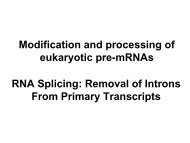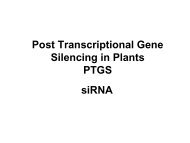You also want an ePaper? Increase the reach of your titles
YUMPU automatically turns print PDFs into web optimized ePapers that Google loves.
339 Establishment of “model genes” to monitor co-transcriptional spliceosome assembly in mammalian cells invivo.A series of model genes, based on the mouse c-fos gene contained on a BAC are under construction in theNeugebauer lab. The model genes have a variable number of introns, from zero to three. Single intron model geneswill be employed to visualize patterns of recruitment of the U1, U2 and U4/U6-U5 trisnRNPs co-transcriptionally inresponse to the transcription of splice junction sequences.340 Feasibility study, targeting PTB regulation of AS to model genes by introduction of MS2 stem loops in intronicpositions (replaces deliverable 218)The Smith and Neugebauer labs have initiated a collaboration, in which MS2 stem loops will be introduced inintrons up- and downstream of an internal alternative exon. A protein consisting of the PTB-RRM2 fused with theMS2 protein will be expressed in cells harboring the model gene and co-transcriptional spliceosome assembly willbe monitored. The Smith lab has already shown in preliminary results that the PTB-RRM2-MS2 protein is capableof mediating PTB regulation on a minigene, by virtue of the interaction between PTB-RRM2 and Raver1.Expectations from current models of PTB function are that RRM2 targeting up- and/or downstream of thealternative exon will reduce association of the U1 and U2 snRNPs with the splice junctions immediately flanking thealternative exon. If feasible, this model will be testable directly in vivo.341 Measure splicing rates in real-time with the MS2-GFP technique. For this, the Bertrand lab will generate areporter RNA containing MS2 sites within the MINX intron, derive stable cell lines expressing the resulting RNA,and determine the kinetic of splicing by photobleaching MS2-GFP at their transcription site.Deliverables215 To determine the molecular basis for the effect of Prp45p on transcription, Beggs will analyse the effects ofprp45 mutant alleles on the recruitment of CTD kinases and chromatin remodeling factors to the ASC1 gene by invivo ChIP assay, and the interaction of these proteins with Prp45p will be tested in pull-down assays in vitro. (month42)216 Aubeouf and Neugebauer will collaborate to establish splicing factor ChIP in MCF7 cell lines. These breastcancer cells are responsive to estradiol, which stimulates transcription of cyclin D1, PS2 and other genes. Thiscellular model will allow us to test the splicing process on gene products made in response to hormones. We willestablish stable cell lines with integrated copies of BACs expressing GFP-tagged versions of U1 70K, U2AF65,Prp8, CBP80 and members of the SR protein family, in order to investigate the interplay between transcription, cotranscriptionalspliceosome assembly and AS outcome. (month 42)219 Bertrand and Neugebauer will collaborate to determine whether splicing of HIV nascent transcripts is cotranscriptional,using a model gene comprising a split MS2 reporter. ChIP of the MS2 binding protein will indicatewhen and where along the gene splicing catalysis occurs. (month 42)334 Use of FISH microscopy assays and ChIP analysis to determine the molecular basis for the effect of mammalianRrp6 on co-transcriptional RNA surveillance (month 54)335 Role of splicing factor Prp45 in transcriptional elongation and pausing (former deliverable 101)336 Regulation of NCAM alternative splicing in neuronal cells337 Role of the RES complex in pre-mRNA splicing surveillance steps.338 Role of the U1 snRNP in “reverse coupling” of HIV transcription and splicing.339 Establishment of “model genes” to monitor co-transcriptional spliceosome assembly in mammalian cells in vivo340 Feasibility study, targeting PTB regulation of AS to model genes by introduction of MS2 stem loops in intronicpositions (replaces deliverable 218)341 Measure splicing rates in real-time with the MS2-GFP technique.268







